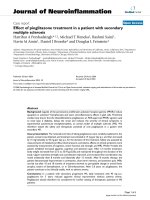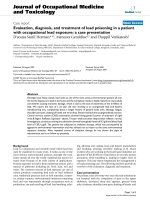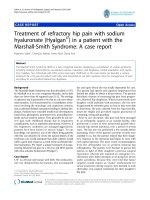Pembrolizumab-associated minimal change disease in a patient with malignant pleural mesothelioma
Bạn đang xem bản rút gọn của tài liệu. Xem và tải ngay bản đầy đủ của tài liệu tại đây (944.44 KB, 3 trang )
Bickel et al. BMC Cancer (2016) 16:656
DOI 10.1186/s12885-016-2718-y
CASE REPORT
Open Access
Pembrolizumab-associated minimal change
disease in a patient with malignant pleural
mesothelioma
Angelika Bickel1*, Irene Koneth2, Annette Enzler-Tschudy3, Jörg Neuweiler3, Lukas Flatz4 and Martin Früh1
Abstract
Background: Pembrolizumab is an anti- Programmed Death 1 (PD-1) antibody approved in melanoma, non-small
cell lung cancer and investigated in malignant pleural mesothelioma.
The most frequent immunotherapy related autoimmune reactions include dermatitis, pneumonitis, colitis,
hypophysitis, uveitis, hypothyreodism, hepatitis and interstitial nephritis.
Case presentation: We describe a 62-year old patient diagnosed with malignant pleural mesothelioma who
experienced ten days after the second dose of third line therapy with pembrolizumab sudden onset of generalized
edema including legs and eyelids and weight gain of 15 kg resulting from nephrotic syndrome and acute renal
failure. Pembrolizumab was discontinued and prednisone, diuretics and angiotensin II receptor blocker were
initiated with full recovery of symptoms and renal function. Pembrolizumab-associated minimal change disease
(MCD) was confirmed by electron microscopy in the renal biopsy.
Conclusion: We are the first to describe pembrolizumab-related minimal change disease (MCD).
Physicians should be aware of this side effect in patients presenting with edema and weight gain and initiate
prompt renal function testing, serum albumin and urinalysis followed by steroid treatment if pembrolizumabrelated MCD is suspected.
Keywords: Malignant Pleural Mesothelioma, PD-1 antibody, Pembrolizumab, Immunotherapy, Minimal change
disease
Abbreviations: MCD, Minimal change disease; PD-1, Programmed death 1
Case presentation
A 62-year old patient was diagnosed with malignant biphasic pleural mesothelioma in June 2014. He experienced progressive disease after six cycles of carboplatin/
pemetrexed and six cycles of second line vinorelbine.
Ten days after the second dose of 200 mg of a third line
therapy with pembrolizumab sudden onset of generalized edema including the legs and eyelids with weight
gain of 15 kg occurred. Nephrotic syndrome with proteinuria of 19 g per day, hypoalbuminemia (15 g/l) and
hypercholesterolemia of 7.8 mmol/l was diagnosed
followed by acute renal failure with a rapid deterioration
* Correspondence:
1
Department of Oncology and Haematology, Cantonal Hospital St. Gallen,
Rorschacherstrasse 95, 9007 St. Gallen, Switzerland
Full list of author information is available at the end of the article
of the estimated glomerular filtration rate from > 90 to
28 ml/min/1.73 m2. Pembrolizumab was discontinued
due to suspected immune-related renal toxicity and
prednisone (1 mg/kg/ day), diuretics and an angiotensin
II receptor blocker was initiated. A renal biopsy showed
diffuse fusions of the epithelial foot processes on electron
microscopy compatible with minimal change disease
(MCD) (Fig. 1). Direct immunofluorescence microscopy
was negative with no complement or immunoglobulin
deposits. Within 5 weeks, creatinine values normalized
and the proteinuria resolved. The patient reported on
symptomatic relief of disease-associated chest pain and
currently remains in stable condition without systemic
therapy 10 weeks later.
© 2016 The Author(s). Open Access This article is distributed under the terms of the Creative Commons Attribution 4.0
International License ( which permits unrestricted use, distribution, and
reproduction in any medium, provided you give appropriate credit to the original author(s) and the source, provide a link to
the Creative Commons license, and indicate if changes were made. The Creative Commons Public Domain Dedication waiver
( applies to the data made available in this article, unless otherwise stated.
Bickel et al. BMC Cancer (2016) 16:656
Page 2 of 3
Fig. 1 Electron microscopy. Glomerular capillary loops with findings of minimal change disease: Podocytes with extensive, diffuse foot process
effacement (with arrows) and microvillous transformation. No electron-dense deposits. Normal thickness of glomerular basement membrane.
Uranyl acetate and lead citrate
Background and Conclusion
Pembrolizumab is an anti- Programmed Death 1 (PD-1)
antibody approved for advanced melanoma that progressed
following ipilimumab and, if BRAF[V600] mutant, a BRAF
inhibitor and for PD-L (ligand) 1 positive advanced nonsmall cell lung cancer after progression to standard
platinum based firstline treatment. It is investigated in multiple cancers including malignant pleural mesothelioma.
Preliminary results of a single arm trial with 25 pretreated
PD-L1- positive mesothelioma patients demonstrated an
encouraging response rate of 28 %, a disease control rate of
76 % including durable response rates and a progression
free survival rate at 6 months of 49 % [1]. Pembrolizumab
disrupts the engagement of PD-1 with its ligands and
impedes inhibitory signals leading to recognition of tumor
cells by cytotoxic T cells. Immune related-adverse events
such as dermatitis, hypophysitis, colitis and hepatitis have
been reported for this class of agents. Whereas interstitial
nephritis is a rare, but a well-recognised serious renal side
effect, MCD has not been described in this context. Early
trials with pembrolizumab have reported grade 3 and 4
edema in two patients [2] without further specification of
the underlying cause. In our patient, clinical signs of
nephrotic syndrome with hypovolemic acute renal failure
and histologic findings on electron microscopy confirmed
the diagnosis. MCD mainly occurs in conditions with activated adaptive immune system such as in young children,
hematologic malignancies and autoimmune diseases. The
pathology of MCD is poorly understood. Alterations of
regulatory T-cells or their differentiation, epigenetic mechanisms and up-regulated secretion of proteins by podocytes
may play an etiologic role. Typically, no specific changes
are notable on light microscopy (ie the term “minimal
change”), electron microscopy almost always shows loss of
podocytes or at least a change of podocyte architecture.
MCD has also recently been described in a patient receiving
ipilimumab and in mesothelioma patients in the absence of
immunotherapy [3, 4]. Whether a structural and functional
similarity of podocytes and mesothelial cells increases the
risk of MCD with immunotherapy in this particular patient
population would have to be further investigated.
To the best of our knowledge, this is the first case of a
pembrolizumab- associated MCD resulting in nephrotic
syndrome and acute renal failure.
Acknowledgments
Not applicable.
Funding
Not applicable.
Availability of data and materials
The datas analysed during the current case report available from the
corresponding author on request.
Authors’ contributions
AB, IK, LF and MF wrote the paper. AET and JN were the histopathologists
and contributed to the histopathological details of the manuscript. All
authors read and approved the final manuscript.
Competing interests
The authors declare that they have no competing interests.
Consent for publication
Informed consent was obtained from the patient for publication of this case
report and any accompanying images. A copy of the written consent is
available for review by the editor of this journal.
Ethics approval and consent to participate
Not applicable.
Author details
1
Department of Oncology and Haematology, Cantonal Hospital St. Gallen,
Rorschacherstrasse 95, 9007 St. Gallen, Switzerland. 2Division of Nephrology
and Transplantation Medicine, Cantonal Hospital St.Gallen, St. Gallen,
Switzerland. 3Institute of Pathology, Cantonal Hospital St. Gallen, St. Gallen,
Switzerland. 4Department of Dermatology, Cantonal Hospital St. Gallen, St.
Gallen, Switzerland.
Bickel et al. BMC Cancer (2016) 16:656
Page 3 of 3
Received: 28 April 2016 Accepted: 14 August 2016
References
1. Alley EW, Schellens JHM, Santoro A, et al. Single-agent pembrolizumab
for patients with malignant pleural mesothelioma (MPM). J Thor Oncol.
2015;10(suppl2), ORAL11.03.
2. Ribas A, Puzanov I, Dummer R, et al. Pembrolizumab versus investigatorchoice chemotherapy for ipilimumab-refractory melanoma (KEYNOTE-002):
a randomised, controlled, phase 2 trial. Lancet Oncol. 2015;16:908–18.
3. Kidd JM, Gizaw AB. Ipilimumab-associated minimal-change disease.
Kidney Int. 2016;89(3):720.
4. Schroeter NJ, Rushing DA, Parker JP, Baltos E. Minimal-change nephrotic
syndrome associated with malignant mesothelioma. Arch Intern Med.
1986;146(9):1834–6.
Submit your next manuscript to BioMed Central
and we will help you at every step:
• We accept pre-submission inquiries
• Our selector tool helps you to find the most relevant journal
• We provide round the clock customer support
• Convenient online submission
• Thorough peer review
• Inclusion in PubMed and all major indexing services
• Maximum visibility for your research
Submit your manuscript at
www.biomedcentral.com/submit









